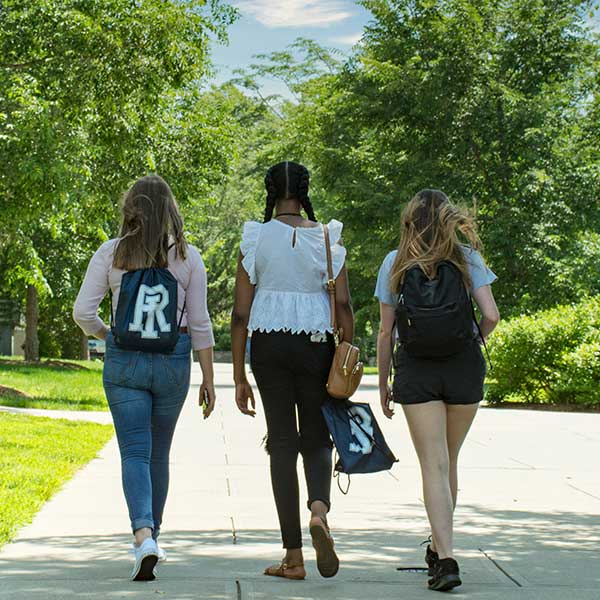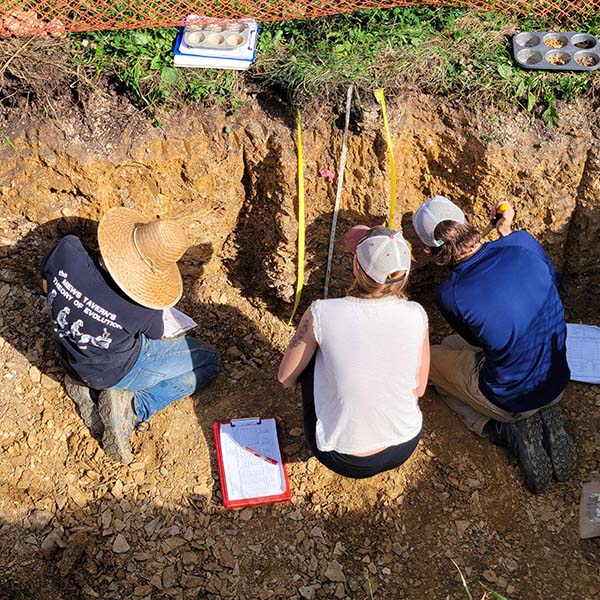A Walk Through Time
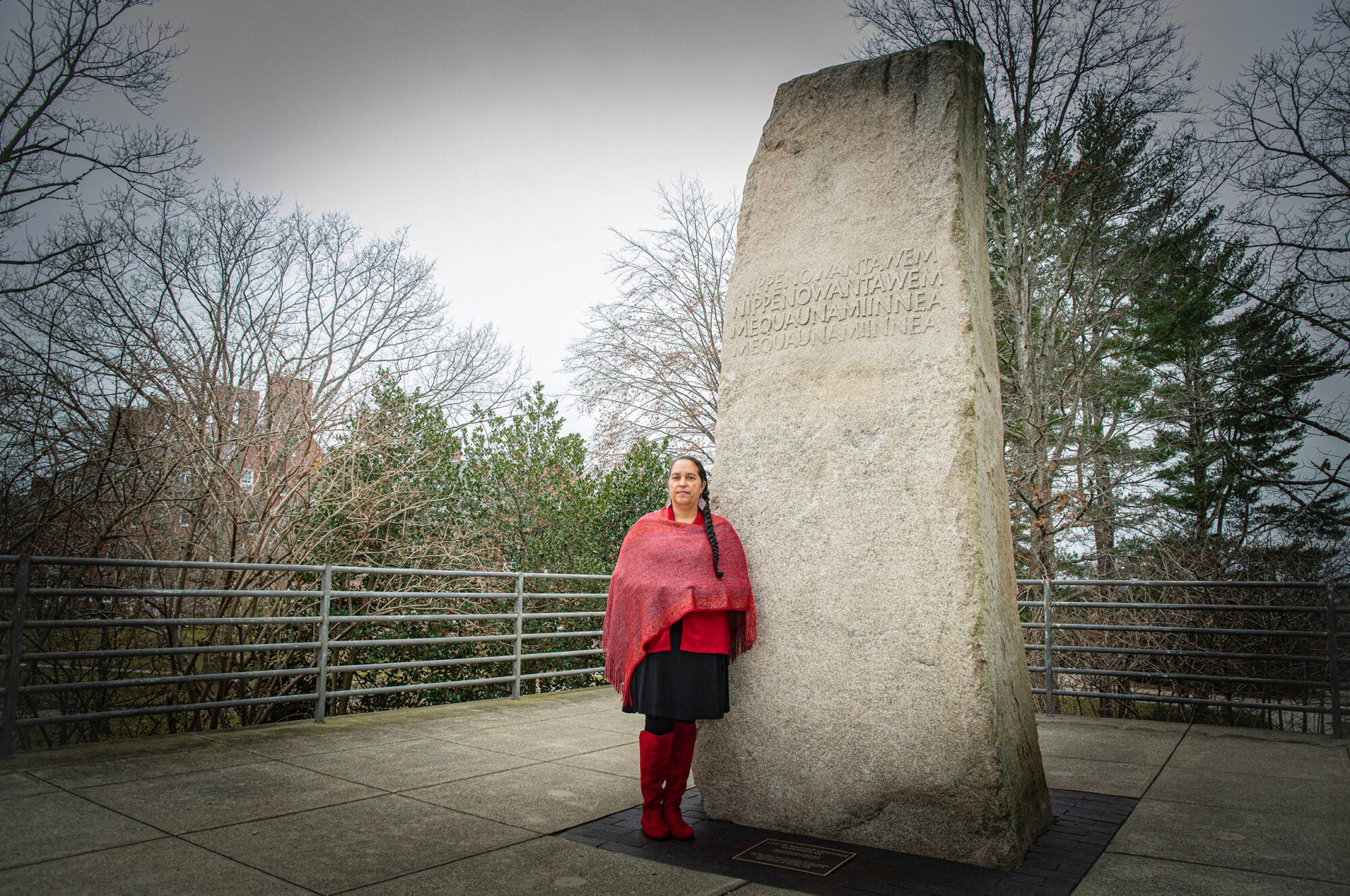
Loren Spears, executive director of the Tomaquag Museum, stands in front of the granite monolith in front of the Robert L. Carothers Library and Learning Commons.
It’s a bone-cold December day, and the atmospheric pressure presages the snow predicted for mid-afternoon. Lorén Spears ’89, Hon. ’17, executive director of the Tomaquag Museum, arms folded underneath her shawl, stands for a portrait beside the 12-foot-high Westerly red granite monolith on the Robert L. Carothers Library and Learning Commons plaza. The monolith leaves her a little cold.
The monolith’s text, phonetic spellings of Narragansett words taken from Roger Williams’ A Key Into the Language of America, reads “Nippenowantawem Nippenowantawem Mequanamiinnea Mequaunamiinnea,” which, in English, says “I am of another language. Remember me.” The call to “remember” the Narragansett people implies that the tribe no longer exists, Spears explains.
A new multidisciplinary undergraduate course at the University, URI Campus: A Walk Through Time, aims to correct such errors as it examines the history of the land on which the Kingston campus sits.
Spears is frank and forthright in talking about how settler colonialism devastated the Narragansett Tribe and how that history relates to URI. The arrival of European colonists was cataclysmic for her ancestors. An initial offensive of war, enslavement, rape and murder was followed by policymaking and legislation that left the Narragansett people much reduced in number and largely stripped of ancestral lands and power. The University of Rhode Island’s Kingston Campus sits on Narragansett ancestral land. In light of that, Spears says some have questioned why the Tomaquag Museum, which has plans to build a new facility on 18 acres of University land, would seek to collaborate with the University.
“My answer has always been that if I want people to broaden their perspectives or to hear or understand a broader Native perspective, you have to collaborate,” Spears says. And those collaborations can be impressive in scale—the new museum will comprise four buildings and cost $10 million—or in scope, such as a new course at URI which enlists undergraduates in research that will educate generations to come.
URI Campus: A Walk Through Time started as a walking tour in 2019. Organized by several academic departments in collaboration with the Tomaquag Museum, the tour was well received, spurring Kristine Bovy, archaeologist and chair of URI’s Department of Sociology and Anthropology, Rod Mather, historical archaeologist and then-chair of the History Department, Catherine DeCesare, historian and an assistant professor in the History Department, and Spears to co-create a one-credit, one-time online course in 2020. An alumni version followed in 2021. Later that year, the organizers reconvened to deliver a URI Center for the Humanities lecture as part of its year-long series Memorials and Commemoration in the U.S. And now, for the first time this spring, undergraduates are taking a three-credit honors version of the course led by DeCesare.
Team-taught and interdisciplinary, A Walk Through Time is ambitious in scope and also mutable. Each semester the course’s focus will change, depending on the interests and expertise of the principal professor teaching it at the time. This semester DeCesare is focusing on women’s history, specifically women’s experiences at URI in the 1960s and ’70s. The course’s aim remains constant, though, which is to educate students on “the long and complicated history of the URI campus land, including ancestral Narragansett land use and effects of European colonization,” according to its syllabus.
Watch the introductory films from URI Campus: A Walk Through Time.
The course spans 5,000 years of history, moving from present to past as it juxtaposes URI’s development with the history of the Narragansett People using a variety of resources: written documents, maps, artifacts, photography, oral histories, and law. The course provides a unique opportunity for undergraduate students to conceive of and conduct original research on a course theme through projects that then become source material for subsequent classes. Theory is, in effect, put into practice as students pursue projects requiring them to evaluate sources and evidence with the critical eye of anthropologists, historians, and archaeologists.
Spears is pleased with the progress thus far.
“When we did the first walk, the first thing I did was to speak in my language, to acknowledge the land that we’re on, to open with what some people would deem a prayer or a blessing, and to ground us in this place,” she says. “As people have become more aware of historical inequities and the voices missing from conversations around our history, there’s been this move to include more voices. Working at Rhode Island’s only Native-led museum opens the door for us to partner on these kinds of projects.”
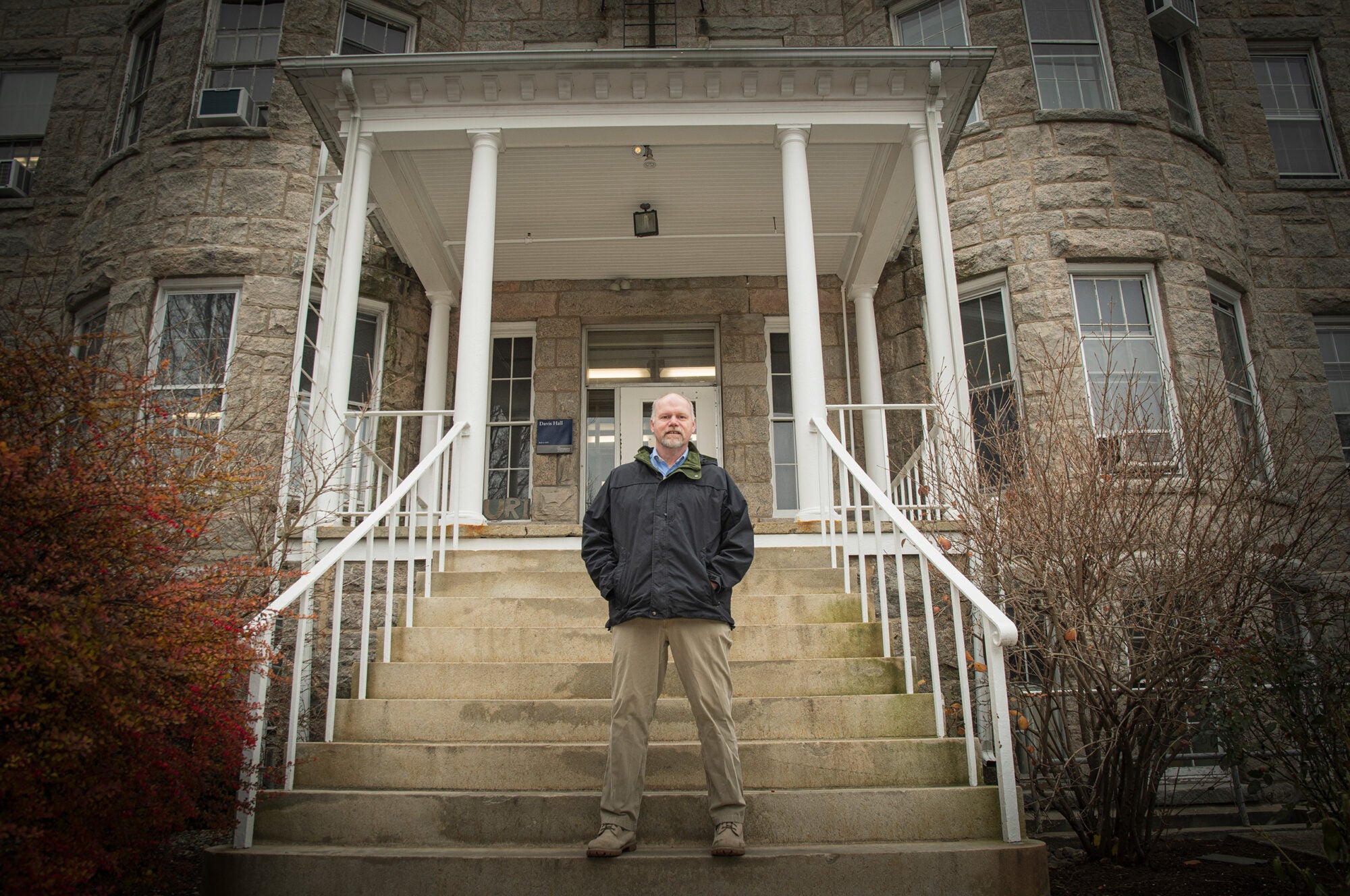
Rod Mather, professor of archaeology, on the steps of Davis Hall
‘This is a global conversation’
A Walk Through Time tethers history to material features of the campus. Green and Quinn halls recall the campus of the 1930s; the quad, the last decade of the 19th and first decade of the 20th century. The Watson House addresses 18th and 19th-century colonial farming; the Niles Burial Ground (aside the south entrance to the Ryan Center) recalls the 17th century. Plains Road and its adjacent parking lots become the backdrop for thousands of years of Indigenous People’s land use. “The focus of the walking tour was this relationship between the University, American traditions, Indigenous People, the land, the landscape’s history and ways of knowing,” Rod Mather says.
Mather expects that the archive the course will generate will expand to include other historically underrepresented groups.
“Everything we’ve done so far has focused on this relationship between Euro-Americans and Indigenous People, but there are other stories we haven’t told yet. Catherine DeCesare is looking at women on campus. We would also like to look more thoroughly at the African American experience on campus.”
Each of the three professors involved in the project intends to pursue discrete lines of historical inquiry that reflect their respective areas of expertise. “My central interest is the campus as cultural landscape. When you read the cultural landscape, when you understand how people have been using a place, you understand what their priorities are, how they affect the place, how the natural environment shapes the way people live in the space, and the kinds of resources they’re trying to extract,” Mather says. “The URI campus is a cultural landscape, a built environment representing our priorities, our prejudices, what we want to remember, and what we want to forget, too.
“The construction of the landscape, for instance, is full of conscious and subconscious meaning, and it reinforces certain messages, right? So, if we have 95% of our buildings named after white men, then that conveys something.”
And so, looking at campus buildings’ names in the aggregate invites analysis of institutional priorities over time—a way of knowing that deepens understanding of the cultural landscape in which the URI community lives, learns, and works. Mather sees this as a welcome opportunity for course correction. “We can’t continue along the road we have, and the first thing to do is to raise awareness, to start the conversations. And then, from the conversations come actions.”
“All over the country, universities are starting to come to terms with their own racial geography,” Mather says. “There’s been a reckoning across university campuses that’s important. Land grant institutions, the whole land grant system, as wonderful as it was in many ways, was predicated on taking land that the federal government had acquired either through treaty or seizure or military action from Indigenous People. So land-grant colleges and universities have got to think about this.
“The conversation is not just a URI conversation. This is a national and global conversation.”
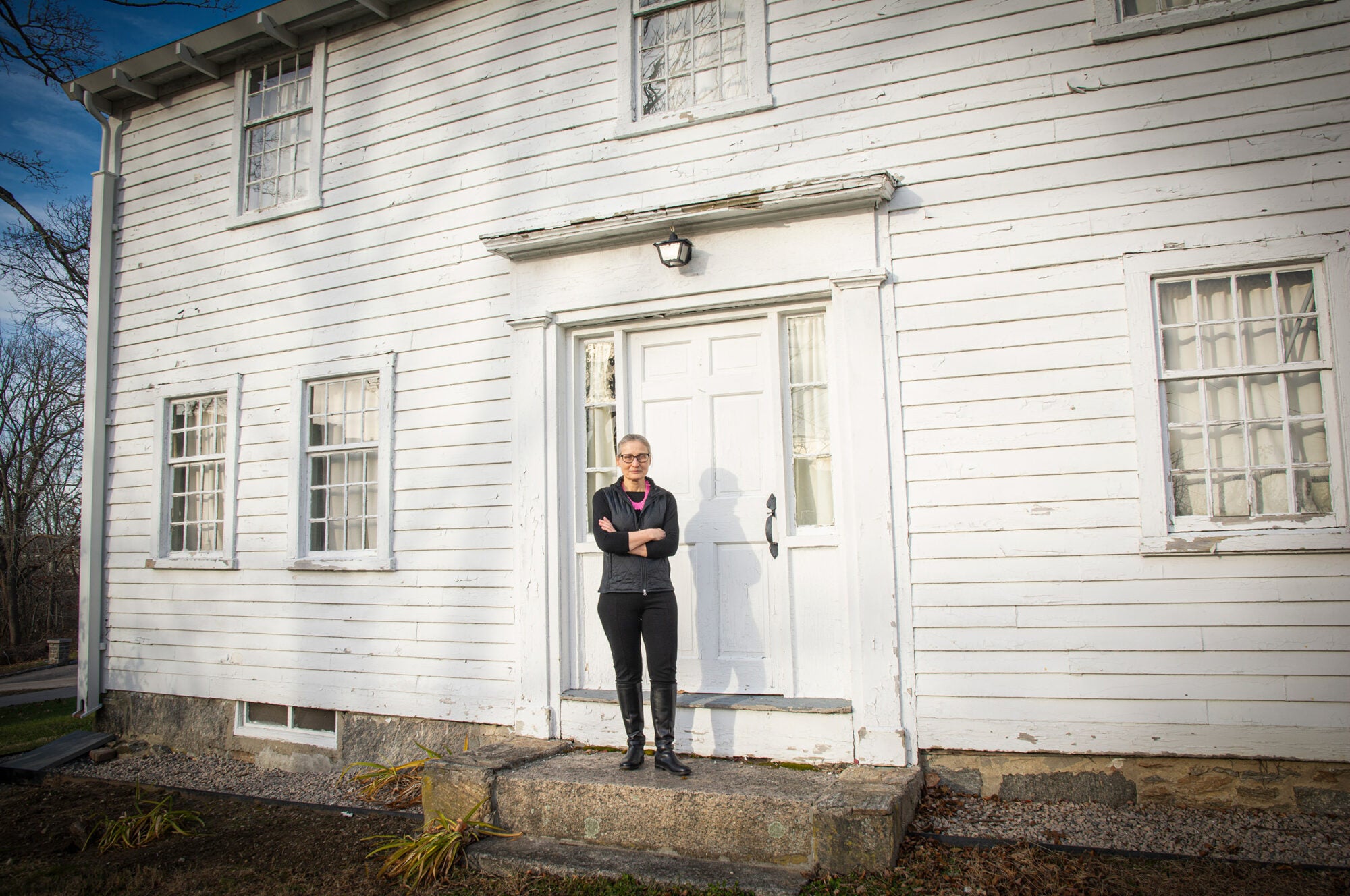
Catherine DeCesare, assistant professor of history, in front of the Watson Farmhouse, the last remaining campus building to predate the establishment of the University.
‘This is breaking new ground’
This spring, Catherine DeCesare became the first of the three academics to teach A Walk Through Time as a traditional three-credit course. This semester’s course is an honors-level offering. A version Walk Through Time will also be proposed as a Grand Challenge course, a designation given to general education courses which delve into complex and multivalent issues of global significance. Given her expertise in Rhode Island history and women’s history, DeCesare has expanded the course to include gendered spaces on the URI campus in the 1960s and ’70s and the impact of second-wave feminism upon them. Last summer, she enlisted Abigail Dodd ’22, Arts and Sciences Undergraduate Research Fellow, to comb university records for women’s involvement on campus over a 30-year span beginning in the 1950s. Dodd created a list of resources to be used by students in planning research projects of their own. DeCesare has also engaged URI graduates who participated in the alumni course to be interviewed by honors students for the purpose of creating an oral history of campus life.
“Students are working on a major project building out a narrative on a topic of their choice; for example, women’s sports, Title IX, sororities or majors. The most prominent major in the 1950s and 1960s was home economics, and they’ll see that transition.”
Students’ archival research and oral reports, as well as their presentations, will be preserved as a course unit, or module, for subsequent student scholars’ use. And so, over time, the archive will grow in size and scope as students from any number of majors, guided by different professors, conduct and interpret original research destined to become part of the University’s—and Rhode Island’s—historical record. Put another way, the students will become historians. DeCesare is excited at the prospect.
“This is breaking new ground in terms of historical research and finding new voices and things to write about,” DeCesare says. “I mean, this is what it’s all about.”
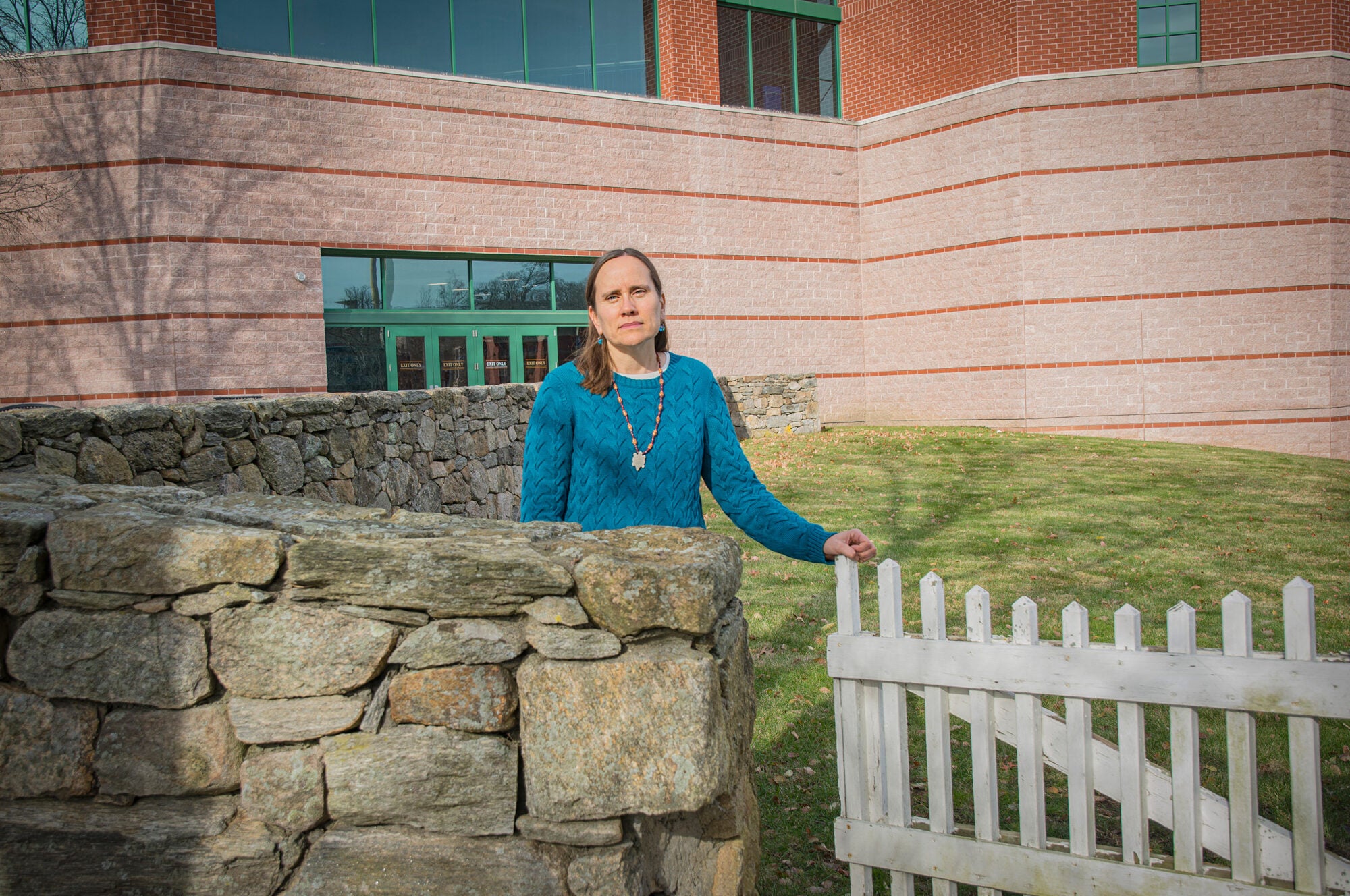
Kristine Bovy, zooarchaeologist, professor of archaeology and chair of the Department of Sociology and Anthropology at the Niles Burial Ground.
‘This history is invisible’
The plaque affixed to the stone wall that encloses the Niles Burial Ground characterizes it as “rooted in Rhode Island’s multicultural history.” Situated in the shadow of the Ryan Center, the burial ground is easily overlooked. The stone walls and white picket gate enclose land believed to hold “the remains of the ancient and diverse settlers,” according to the plaque, which is the burial ground’s only marker. There are no headstones in Niles Burial Ground. The plaque’s last two sentences explain why: “This burial ground could contain the remains of the Niles family as well as Native Americans and African Americans who worked this land. It is preserved to acknowledge our past and enrich our future.”
For Loren Spears, the language of commemoration is often vexed. In the Center for the Humanities lecture given last fall, Spears began her address by saying, “I must acknowledge the 400 years of conquest colonization, genocide, land dispossession, enslavement, forced assimilation, detribalization, and erasure of the Narragansett and other Indigenous nations of the Americas. I must also acknowledge the bravery, resilience, perseverance, and adaptability of our ancestors, who ensured our continuation, passing forth our traditional ecological knowledge, language, history, and culture, while contributing to the creation of this colony, state, and country.
“There is no U.S. history without Indigenous People’s history, and there is no Rhode Island history without Narragansett, Niantic, and other Indigenous Peoples’ history. This is our homeland since time immemorial. We are still here.”
So, to say Native and African Americans “worked the land” does more than skirt the issue for Spears. Such language obfuscates, conceals, and dissembles. It undermines the historical record, she contends.
“When people say of Indigenous Peoples, ‘Oh, they were servants,’ no, we weren’t servants. We were slaves because we were forced, kept against our will for long periods of time, victimized by violence to keep us there.”
The January 6 storming of the United States Capitol may have been one of the most dramatic moments of iconoclastic behavior ever enacted on United States soil, but it was hardly the only time Americans have turned to the desecration and destruction of the historical to punctuate their anger. That’s a history that dates to just five days after the signing of the Declaration of Independence, when newly minted Americans tore down a gilded statue of King George III that had been erected in Manhattan. Some would argue, though, that exclusion from the historical record is an act of equal violence and one much harder to repair.
How do you address archival silence; that is, the experience of people omitted from historical records? What can be done for the nameless who may be interred in Niles Burial Ground, for instance? What can be done when there is no historical record from which to begin? Kristine Bovy and her colleagues see A Walk Through Time as a multi-pronged method to address, augment and amend the past.
“As archaeologists and historians, we realized that this land had a much deeper past, a much deeper history,” Bovy says. “We initially focused on the history of the university, and especially the Narragansett ties to this land because this history is invisible to most members of our community.”
That the collective energies of scholars with differing areas of expertise are being brought to bear on the history gets to a more complete picture, too. Archaeology, history, museum archival work—each informs and complements the others.
“Archaeology is another way that we know about the past. We systematically excavate objects; we record their context, and we analyze them,” Bovy says. “And the power of archaeology is really in providing information about people and activities that is left out of written records.”
Supplement the disciplines with the power of an inquisitive and motivated student body and progress is assured, Bovy says.
“Our students will help us do the research and fill in some of the gaps in these important periods of time. They’ll help build out that content more. We’re going to highlight what is visible, what’s invisible, what’s remembered and what’s not remembered, and what’s memorialized and not memorialized on this land.”
‘The truth is the truth’
Opportunities to recover erased histories have the potential to expand minds, Loren Spears says. For that reason, she says, work such as that being done by the University will find a willing partner in the Tomaquag Museum. Beyond the obvious benefit of building an archive, courses such as A Walk Through Time have the potential to move a community past errant history toward a more equitable—and honest—future, Spears says. Eventually, Spears hopes there’ll be enough material compiled to create a Native Studies program at URI.
“Partnerships like A Walk Through Time broaden people’s understanding of the history of this campus and take it beyond the literal creation of the campus. People like to term such things ‘revisionist history.’ I disagree wholeheartedly. We are not rewriting history. We are including facets that have been erased from the documentation of the history.”
Spears invokes the words of the late Ella Sekatau, Narragansett poet, historian, ethnohistorian and medicine woman to punctuate her point:
“The truth is the truth is the truth waiting to be recovered.”
—Marybeth Reilly-McGreen

